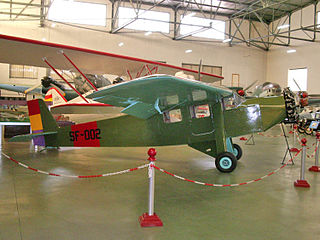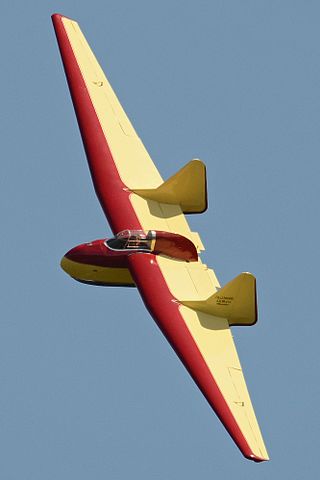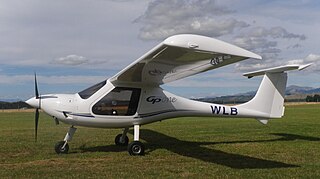
The Savoia-Marchetti SM.81 Pipistrello was the first three-engine bomber/transport aircraft serving in the Italian Regia Aeronautica. When it appeared in 1935, it represented a real step ahead in Italian military aviation: it was fast, well armed and had a long range. It proved effective during the war with Ethiopia and the Spanish Civil War. Despite being too slow to remain competitive as a bomber in the later years of World War II, it was one of the most flexible, reliable and important aircraft of the Regia Aeronautica from 1935 to 1944, and adapted to second-line duties in a wide range of tasks.

The Farman F 400 was a 1930s French three-seat cabin high-winged monoplane which was designed and built by Farman.

The Fairchild XC-120 Packplane was an American experimental modular aircraft first flown in 1950. It was developed from the company's C-119 Flying Boxcar, and was unique in the unconventional use of removable cargo pods that were attached below the fuselage, instead of possessing an internal cargo compartment.

The Heinkel He 72 Kadett (Cadet) was a German single-engine biplane trainer of the 1930s. It was known to its pilots as the Zitterrochen as it shook madly.

The Kokusai Ku-7 Manazuru was a large experimental twin boom Japanese military glider.

The Fauvel AV.36 was a single-seat tailless glider designed in France in the 1950s by Charles Fauvel. Although the "AV" in AV.36 stands for Aile Volante, it was not a true flying wing: it featured two large fins mounted on stubby tailbooms extending back from the wing's trailing edge, and accommodated the pilot within a stubby fuselage. The aircraft was designed to be quickly disassembled for road transport, with the nose detaching, and the fins able to fold back against the trailing edge of the wing. A refined version with a slightly longer wingspan, the AV.361 was introduced in 1960.

The Savoia-Marchetti SM.91 was a two-seat, twin-engined, Italian heavy fighter prototype, designed to compete in a 1942 revision to a long-range fighter-bomber contract offered by the Regia Aeronautica to Italian aircraft companies in 1938. The original 1938 specification yielded the Savoia-Marchetti SM.88, which the SM.91 was largely based on.

The Savoia-Marchetti SM.78 was an Italian bomber/reconnaissance biplane flying boat of the early 1930s.

The Savoia-Marchetti SM.62 was an Italian single-engine maritime patrol flying boat produced from 1926. It served with the Regia Aeronautica and with a number of foreign users, and was produced in Spain and the Soviet Union. Some of the Spanish aircraft were still in service during the Spanish Civil War.

The International F-17 Sportsman was a 1920s American three-seat open-cockpit biplane designed and manufactured by the International Aircraft Corporation in Long Beach, California and Cincinnati, Ohio. 107 aircraft were built, 77 of them at Cincinnati.

The Stearman M-2 Speedmail was a mail-carrier aircraft produced by the Stearman Aircraft Company of Wichita, Kansas. It first flew in January 1929. The Speedmail was a single-seat biplane, with two large cargo compartments in place of a front cockpit. The fuselage and tail unit were constructed from welded chrome-moly steel tube faired with wooden formers and fabric covered aft of the pilot's cockpit, and detachable aluminium alloy panels covered the fuselage forward of the cockpit. The wings were constructed from spruce spars and plywood built-up ribs, all fabric covered. It differed from previous Stearman aircraft by having a tailwheel instead of a tailskid due to its size and weight.

The Titan Tornado is large family of cantilever high-wing, pusher configuration, tricycle gear-equipped kit aircraft manufactured by Titan Aircraft of Austinburg, Ohio, for amateur construction.

The Fly Synthesis Texan is an Italian ultralight and light-sport aircraft, designed and produced by Fly Synthesis and which has been in production since 1999. The aircraft is supplied as a complete ready-to-fly-aircraft.

The Flyitalia MD3 Rider is an Italian ultralight and light-sport aircraft that was designed by Jaro Drostal in the Czech Republic and produced by Flyitalia of Dovera, Italy. The aircraft was supplied by Flyitalia complete and ready-to-fly.

The Jabiru J230 is an Australian light-sport aircraft, designed and produced by Jabiru Aircraft. The aircraft is supplied as a kit for amateur construction or as a complete ready-to-fly aircraft.

The Norman Aviation Nordic VII is a Canadian advanced ultralight aircraft, that was designed by Jacques Norman and produced by Norman Aviation of Saint-Anselme, Quebec. The aircraft was supplied as a kit for amateur construction or as a complete ready-to-fly-aircraft.

The Skyleader GP One is a Czech ultralight aircraft, designed and produced by Skyleader Aircraft and introduced at the AERO Friedrichshafen show in 2010. The aircraft is supplied as a complete ready-to-fly-aircraft.
The ICP Amigo is an Italian homebuilt aircraft that was designed and produced by ICP srl of Piovà Massaia. When it was available the aircraft was supplied as a kit for amateur construction.
The Sunward ST is a Chinese ultralight trike designed and produced by Sunward Tech of Zhuzhou. The aircraft is supplied complete and ready-to-fly.

The Caproni Ca.105 was a multirole high wing single engine monoplane developed by the Italian aeronautical company Aeronautica Caproni in the late 1920s.

















